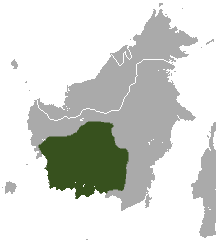Whitebeard Gibbon
| Whitebeard Gibbon | ||||||||||||
|---|---|---|---|---|---|---|---|---|---|---|---|---|

White-bearded gibbon ( Hylobates albibarbis ) |
||||||||||||
| Systematics | ||||||||||||
|
||||||||||||
| Scientific name | ||||||||||||
| Hylobates albibarbis | ||||||||||||
| Lyon , 1911 |
The Bornean white-bearded gibbon ( Hylobates albibarbis ) is a taxonomically controversial primacy of the family of gibbons (Hylobatidae). It was listed either as a subspecies of the gray gibbon or the black-handed gibbon , in more recent systematics and in the following considered as a separate species .
features
No exact body measurements are known, white bearded gibbons can weigh up to 6 kg. This species is similar to the black-hand gibbon , but has no black fur, but the most colorful and contrasting of all gibbon species. This is light grayish-brown and turns gold on the trunk with blackish regions on the hands and feet and on the stomach. The hair on the head is directed backwards like a fan. The parting is outlined dark and yellow-brown. Males also often have a light-colored genital tuft.
distribution and habitat
The white-bearded gibbon is found only in southwest borneo (in the provinces of West Kalimantan and Central Kalimantan ).
Primary and secondary forests, but also selectively deforested tropical, evergreen forests at an altitude of 1200 m and bog and swamp forests represent the habitat . The population density decreases at higher altitudes.
Way of life
The white-bearded gibbon is a diurnal tree dweller. In the Sabangau National Park, Central Kalimantan, he spends an average of 29% of the day eating food, 29% resting, 29% hiking through the area, 9% singing and 4% doing social activities such as playing or grooming each other.
The average size of a territory is 28 to 47 ha. In general, males are very aggressive towards one another and defend the group's territory. Females, on the other hand, lead the group and drive away other females.
The white-bearded gibbon is mainly a fruit-eater, which prefers fruits with a high sugar content, but also feeds on young leaves and insects , and if there is a lack of ripe fruits also on unripe and lianas.
Males and females reach sexual maturity at 6 to 8 years of age.
The large hybrid zone of the whiskered gibbon and the gray gibbon is near Muarajuloi between the Busang and Murung Rivers on the upper reaches of the Barito and presumably extends to the upper part of the Kapuas River. The known part of the zone covers several 1000 km 2 . Nevertheless, it is relatively sparsely inhabited with three groups per km² and animals that are not hybrids are rare or do not exist at all. The chants lie between those of the parents.
threat
The white-bearded gibbon is classified by the IUCN as "endangered" (highly endangered). It is protected in Indonesia and is largely at risk from habitat destruction from fire, illegal logging and the spread of oil palm plantations. Most whiskered gibbons live in swamp forests, an extremely endangered habitat that is getting smaller and smaller, mainly due to drainage, deforestation and fire. Particularly large forest fires in the 1990s and continuous clearing had or still have the greatest impact on the population. The animals are hunted for their meat and to be sold as pets. The whiskered gibbon is found in six nature reserves and is quite common in suitable habitats. A preliminary count suggests that about 19,000 individuals are found in the mixed swamp forests in Sabangau National Park, which is home to one of the largest populations. However, it is not known how many white-bearded gibbons there actually are.
Systematics
The systematic position of the white-bearded gibbon is controversial, it seems to be a separate species. Due to the external similarities with the black-handed gibbon and the hybridizations with the gray gibbon, it is assigned as a subspecies to the black-handed gibbon ( H. agilis albibarbis ) in some systematics , in others to the gray gibbon ( H. muelleri albibarbis ).
Individual evidence
- ^ A b Thomas Geissmann: Status reassessment of the gibbons: results of the Asian primate red list workshop 2006. ( Memento from March 28, 2012 in the Internet Archive ) (PDF) In: Gibbon Journal 3, 2007, pp. 5-15.
- ↑ Susan M. Cheyne, Claire JH Thompson, Abigail C. Phillips, Robyn MC Hill, Suwido H. Limin: Density and population estimate of gibbons (Hylobates albibarbis) in the Sabangau catchment, Central Kalimantan, Indonesia. In: Primates 49, No. 1, 2008, pp. 50-56, doi: 10.1007 / s10329-007-0063-0 .
- ↑ Erin R. Vogel, Livia Haag, Tatang Mitra-Setia, Carel P. van Schaik, Nathaniel J. Dominy: Foraging and ranging behavior during a fallback episode: Hylobates albibarbis and Pongo pygmaeus wurmbii compared. In: American Journal of Physical Anthropology 140, No. 4, 2009, pp. 716-726, doi: 10.1002 / ajpa.21119 .
- ^ Russell A. Mittermeier, Anthony B. Rylands, Don E. Wilson: Handbook of the Mammals of the World. Volume 3: Primates. Lynx Edition, Barcelona 2013, ISBN 978-84-96553-89-7 , pp. 780–781.
literature
- DE Wilson & DM Reeder: Mammal Species of the World . Johns Hopkins University Press, 2005. ISBN 0-8018-8221-4
- Russell A. Mittermeier, Anthony B. Rylands, Don E. Wilson: Handbook of the Mammals of the World. Volume 3: Primates. Lynx Edition, Barcelona 2013, ISBN 978-84-96553-89-7 , pp. 780–781.
Web links
- Information from the Gibbons Research Lab. (English)
- Hylobates albibarbis in the endangered Red List species the IUCN 2006. Posted by: A. Eudey & Members of the Primate Specialist Group, 2000. Retrieved on August 2 of 2007.
